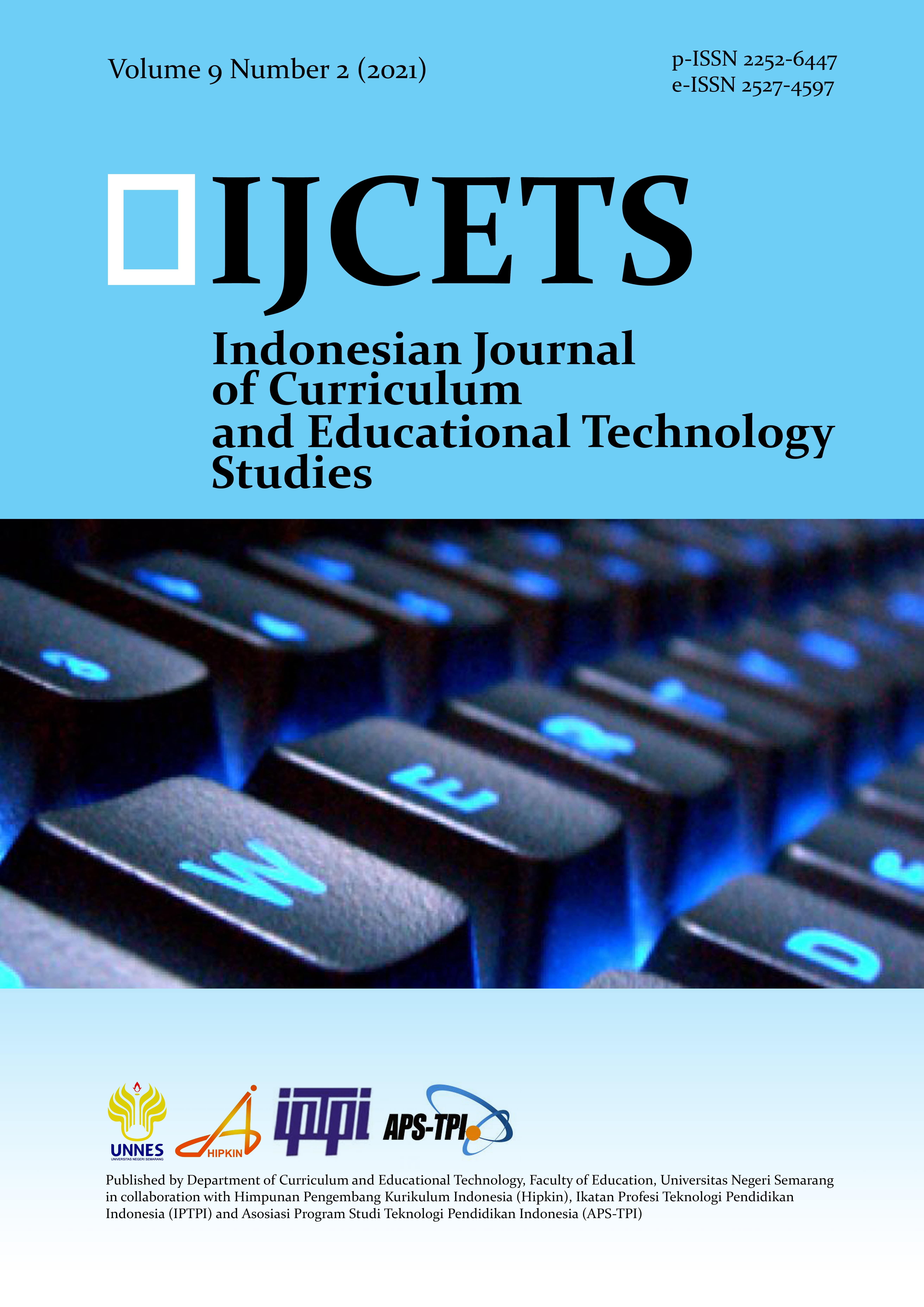Abstract
Models are direct replicas, images, or copies of real objects or figures. They are made in place of the original object and therefore used as such in place of the original. Inability to have access to mammalian internal organs is one of the challenges in teaching some concepts in Biology. Hence, the need to develop a 3-dimensional automated model of the human heart (3-DAMHH) to teach Biology concepts in Ilorin, Nigeria. The study was a developmental research design model. ADDIE model was adopted. The findings of this study revealed that a 3-dimensional (3D) automated model of the human heart was successfully developed with silicon gum, pop, oil paint, hosepipe, pumping devices, transformer, and diode. Findings also revealed that a 3-dimensional automated model of the human heart was cost-effective. This study recommends biology teachers use 3-DAMHH for teaching abstract concepts in biology.
Abstrak
Model adalah replika langsung, gambar atau salinan dari benda atau angka nyata yang dibuat sesuai dengan objek aslinya dan karenanya digunakan seperti objek aslinya. Ketidakmampuan untuk mengakses organ dalam mamalia merupakan salah satu tantangan dalam mengajarkan beberapa konsep dalam mata pelajaran Biologi. Oleh karena itu, perlu dikembangkan model jantung manusia otomatis 3 dimensi (3-DAMHH) untuk mengajarkan konsep Biologi. Dalam hal ini ini peneliti mengambil konteks di Ilorin, Nigeria. Penelitian ini merupakan penelitian pengembangan menggunakan model ADDIE. Temuan penelitian ini mengungkapkan bahwa: model jantung manusia otomasi 3 dimensi berhasil dikembangkan dengan permen karet silikon, pop, cat minyak, selang, perangkat pompa, transformator, dan dioda. Temuan lain juga mengungkapkan bahwa model otomatis 3 dimensi jantung manusia hemat biaya. Studi ini merekomendasikan agar para guru Biologi menggunakan 3-DAMHH untuk mengajar konsep abstrak dalam biologi dalam pembelajaran mereka.
References
Akinfe, E., Olofinniyi, O. E., & Fashiku, E. O. (2012). Teachers’ Quality as Correlates of Students Academic Performance in Biology in Senior Secondary Schools of Ondo State, Nigeria. Online Journal of Education Research, 1(6), 108-114.
Awolaju, B. A. (2016). Instructional Materials as Correlates of Students’ Academic Performance in Biology in Senior Secondary Schools in Osun State. International Journal of Information and Education Technology, 6(9), 705-708.
Bingimlas, K. A. (2017). Barriers to the Successful Integration of ICT in Teaching and Learning Environments: A Review of the Literature. Eurasia Journal of Mathematics, Science and Technology Education, 5(3), 235-245.
Bisiriyu, A. A. (2016). Instructional Materials as Correlates of Students’ Academic Performance in Biology in Senior Secondary Schools in Osun State. International Journal of Information and Education Technology, 6(2) , 705-708.
Christine, T. (2014). Importance of Instructional Materials in Teaching & Learning Integrated Science. Retrieved from classroom sycronym website: https://classroom.synonym.com/importance-teaching-learning-integrated-science-7191804.html
Culatta, & Richard. (2019). The process by which instruction is improved t the analysis of learning needs and systematic development of learning experiences. Retrieved from IstructionalDesign.org: https://www.instructionaldesign.org/
Daramola, F. O. (2016). Basic Concept in Educational Technology. In M. O. Yusuf, & S. A. Onasanya, Critical Issues in Educational Technology (pp. 1-8). Ilorin, Nigeria: Depatment of Educational Technology, University of Ilorin.
Duhaney, & Devon, C. (2010). Technology and the Educational Process: Transforming Classroom Activites. International Journal of Instructional Media, 27(1), 69.
Educational and Instructional Technology (2015). Intergrating Technology into the Classroom.RetrievedfromEducation+and+Instructional+Technology:http://integratingtechnologyintotheclassroom.wikispaces.com
Engida, T. (2012). Development of Low-cost Educational Materials for Chemistry. AJCE Special Issue, 2(1).
Hillen, S. A., & Landis, M. (2014). Two Perspectives on E-Learning Design: A Synopsis of a U.S. and a European Analysis. The international Review of Research in Open and Distance Learning, 15(4), 17-83.
Kareem, A. A., & Olafare, F. O. (2017). Comparative Study of the Effects of Computer Assisted Instruction on Student's Academic Achievement in Science Subject in High Schools in Osun State, Nigeria. Association for Innovative Technology Integration in Education (AITIE), 1(1),29-36.
Lewis, T. (2016, March 22). Human Heart: Anatomy, Function & Facts. Retrieved from LIVE SCIENCE: https://www.livescience.com/34655-human-heart.html
Matthew, M. (2014, n.d n.d). Human Anatomy. Retrieved from WedMD: https://www.webmd.com/heart/picture-of-the-heart#1
Musah, A., & Umar, A. A. (2017). Effects of Availability and Utilization of Biology Laboratory Facilities and Students’ Academic Achievements in Secondary Schools in Yobe State, Nigeria. International Journal of Innovative Social & Science Education Research, 5(2), 1-8.
National Commprehensive Center. (2010). Conducting a Cost Analysis for Educational Policies: Teacher Effectiveness. Retrieved from National Comprehensive Center: https://gtlcenter.org/sites/default/files/docs/ConductingCostAnalysis.pdf
Nneamaka, O. (2018). 10 Problems of Science Education in Nigeria and Posible Solution.RetrievedfromInfoGuideNIGERIA.com:https://infoguidenigeria.com/science-education-nigeria/
Ogunlade, O. O., & Amosa, A. A. (2015). Effect of Audio Instructional Package on Basic Pupils' Performance in English Pronunciation Skills in Ilorin, Kwara State, Nigeria. 1-10.
Olumorin, C. O. (2016). Design and Production of 3-dimensional Instructional Models and Specimens. In M. O. Yusuf, & S. A. Onasanya (Eds), Critical Issues in Educational Technology. Ilorin: Department of Educational Technology, University of Ilorin, 62-68.
Olumorin, C. O., Yusuf, A., Ajidagba, U. A., & Jekayinfa, A. A. (2010). Development of Instructional Materials from Local Resources for Art-Based Courses. Asian Journal of Information Technology, 9(2), 107-110.
Omorogbe, E., & Ewansiha, J. C. (2013). The Challenge of Effective Science Teaching in Nigerian Secondary Schools. Academic Journal of Interdisciplinary Studies, Vol2 No7, 181-188.
Onasanya, S. A. (2016). Design and Production of Instructional Materials. In M. O. Yusuf, & S. A. Onasanya, Critical Issues in Educational Technology (p. 44). Ilorin: Department of Educational Technology, University of Ilorin.
Pappas, C. (2018). The Role of Instructional Designers. Retrieved from eLearning Industry: https://elearningindustry.com
Samikwo, D. C. (2017). Factors Which Influence Academic Performance in Biology in Kenya: A Perspective for Global Competitiveness. International Journal of Current Research, 5(12), 4296-4300.
Serhat, K. (2017). Framework and Theories/ADDIE Model: Instructional Design. Retrieved from Educational Technology: https://educationaltechnology.net/the-addie-model-instructional-design/
Sivakumar, R. (2015). Impact of Low Cost Teaching Aids in Teaching Science. Innovation Thoughts Research Journal, 2(3), 31-44.
